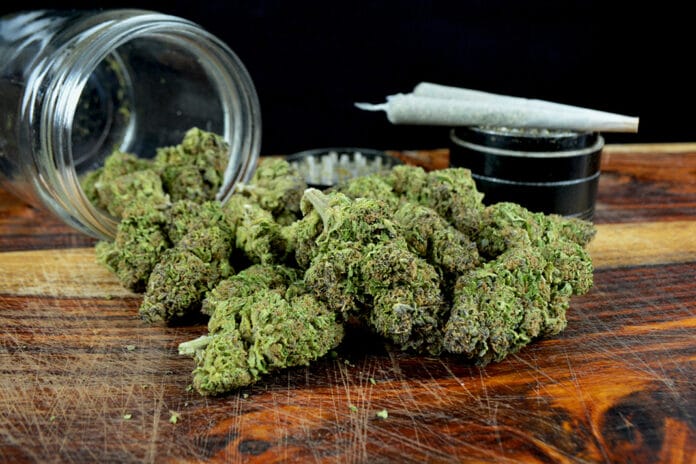The legalization and decriminalization of marijuana use medically and recreationally have increased over the years. Although seven states are still waiting on approval from legislatures, 16 states have declared full legalization of the use of medicinal marijuana, as well as recreational marijuana. The remaining states vary between medical use only or the use of CBD oils for medical purposes.1
However, the social gains of marijuana use may have negative impacts on dental patients’ oral and medical health. Treatment and recommendations are adjusted for dental patients where signs or symptoms of marijuana use are observed.
Marijuana
Marijuana is “the psychoactive dried resinous flower buds and leaves of the female hemp or cannabis plant that contain high levels of THC and are smoked, vaped, or ingested (as in baked goods) especially for their intoxicating effect.”2 Marijuana has unique properties such as a mild sedative, mood enhancer, analgesic, and antiemetic. There are roughly 500 compounds, of which 120 are cannabinoids.
Cannabinoids are “a class of chemicals that directly interact with the nervous systems endogenous cannabinoid receptors.”3 The human brain, as determined in the 1980s, “has more receptors than any other G protein-coupled receptor (GPCR) type.”3 The G protein-coupled receptor comprises CB1 and CB2 receptors that detect molecules on the outside of the cell and, in return, this activates a cellular response. The CB1 receptor controls the peripheral and central nervous system, whereas the CB2 inhibits presynaptic inhibition and is unique to only sensory neurons.4
The Centers for Disease Control and Prevention indicates that 22.2 million people use marijuana each month and, according to the recent Trends of the Future study conducted, eighth and tenth-grade student use has increased since the availability of THC in over-the-counter vaping modules; 4% of twelfth graders vape THC daily.5,6
Some of the compounds to discuss here include:
THC ─ The most widely recognized compound of the cannabis plant is tetrahydrocannabinol, also known as THC. This active ingredient determines the psychoactive effects of marijuana, such as altering perception, mood, consciousness, and cognitive behavior.
The concentration of THC may vary depending on the vehicle of use.3 When marijuana is smoked, the THC concentration is between 0.5% to 9.6%. However, ingestion through baked goods has a 2% to 20% THC concentration. In addition, the most potent concentration of THC, ranging from 66.4% to 75.5%, is while vaping.3
CBD ─ Another widely known cannabinoid compound of the cannabis plant is cannabidiol (CBD), which was discovered in 1940 and accounts for 40% of the plant’s extract. CBD is suggested to aid in decreasing anxiety, cognition, movement disorders, and decreasing pain. However, it does not have the same psychoactive properties like THC and may interfere with tetrahydrocannabinol when used in combination with it.7
The vehicles of which CBD is used include smoking, aerosols, spray, and oils. The CBD oils may consist of capsules for ingestion, dried plant, spray for topical use, and prescription liquids. Although CBD is widely used and accessible over the counter, CBD has yet to receive FDA approval.
Carcinogens ─ According to the American Lung Association, cannabis contains many carcinogenic chemicals. For example, some commonly known chemicals and agents include ammonia, arsenic, hydrogen cyanide, and formaldehyde.
In addition, cannabis contains the carcinogen acetaldehyde, which is found in not only marijuana but tobacco smoke as well. Other carcinogens of marijuana that may be byproducts of the processing or the vehicle of use are cadmium, chromium, lead, mercury, and nickel.7
Marijuana Effects on Health
Adverse medical effects ─ As with tobacco use, there are many medical conditions that may be a result of marijuana use. An immediate cardiovascular event is the most prevalent. The use of marijuana increases the heart rate (tachycardia) and may induce sudden cardiac death during intoxication.3 The use of marijuana also causes microcirculation disruption, which may result in stroke or vascular occlusive disease, also known as “cannabis arteritis.”7
In addition to cardiovascular disease, respiratory disease is another known adverse medical effect of marijuana. Symptoms such as chronic bronchitis, throat irritation, and airway resistance can result from smoking marijuana. Also, due to marijuana’s high concentration of chemical agents, lung disease and cancer are a cause for concern.8
Adverse dental effects ─ Like tobacco use, the clinical reactions to smoking marijuana include leukoplakia, hyperplasia, thrush, stomatitis, and xerostomia. Marijuana use also increases the risk of periodontal disease, including alveolar bone loss as well as an increased risk of caries.
THC is an appetite stimulant and, therefore, snacking of sugary foods and drinks after marijuana use promotes the prevalence of caries.3 The presence of xerostomia will also aid in a more acidic oral environment, thus increasing the risk of caries.
Clinical Dental Examination
During the clinical examination of the dental patient, observing signs and/or symptoms of marijuana use will be crucial to determining the course of treatment and recommendations. Upon seating the dental patient, the extrinsic signs of current marijuana use may include pupil dilation, hyperactivity, paranoia, and delusional behavior. Also, blood pressure readings may show an increase in systolic blood pressure, which would contraindicate the use of epinephrine.3
Another effect of marijuana use is tachycardia, which would be indicative of the patient complaining of fatigue, dizziness, or irregular heart palpitations. Therefore, if the clinical examination indicates positive marijuana use, the initiation of questions with regard to tachycardic symptoms would be recommended for the dental clinician.
Nevertheless, the oral cavity will tell its own story of possible chronic marijuana use. Such oral markers would be hyperplasia, xerostomia, leukoplakia, candidiasis, periodontitis, and often green stain present on the tooth surface. In chronic marijuana users, periodontal disease is present at an earlier age and typically has higher periodontal pocket depths due to the alveolar bone loss.
As previously mentioned, THC is an appetite stimulant that causes increased food intake after use. Ingestion of high sugary snacks increases the presence of tooth decay, as does the dry mouth effects of smoking marijuana.3 In combination with marijuana use, the dental patient may have a history of tobacco, alcohol, and other drug use.
Chronic marijuana use may be indicated by overall poor oral health care and inconsistent dental visits. Therefore, being aware of a history of use is necessary to determine anesthetic use during treatment and to help promote positive dental health.
Recommendations
After completion of a thorough dental and medical history and determining the frequency of marijuana use with the dental patient, key steps are taken to ensure, promote, and encourage oral care. Primarily, emphasizing the importance of regular dental visits and oral home care is an essential step. In addition, reviewing dietary contributions to decay and the avoidance of cariogenic snacks and beverages will promote positive oral health.
In the presence of any dental disease or adverse oral concern, the choice of treatment to serve the dental patient may vary. For example, if the dental patient presents with a history of caries or current high caries rate or xerostomia, then long-term treatment should include topical fluoride applications nightly to reduce the risk.
Also, educating the patient about the health risks of using anesthesia with epinephrine during treatment in conjunction with marijuana and advising them to refrain from use on treatment days would be recommended.
Lastly, cessation and advising the patient of the current state law in reference to marijuana, when applicable, may prevent future use.
Overall, the legalization of marijuana for social gains may increase community use and, therefore, have an impact on the dental community due to the adverse medical and oral implications. Understanding the signs and symptoms of a chronic marijuana user and implementing treatment and education accordingly will help to ensure positive oral health in the future.
Need CE? Click Here to Check Out the Self-Study CE Courses from Today’s RDH!
Listen to the Today’s RDH Dental Hygiene Podcast Below:
References
- Map of Legality by State: Wondering What the Law Is in Your State? (2021, June). DISA Global Solutions. Retrieved from https://disa.com/map-of-marijuana-legality-by-state
- Marijuana. (n.d.). Merriam Webster Dictionary. Retrieved from https://www.merriam_webster.com/dictionary/marijuana
- Cannabis: Oral Health Effects. (n.d.). American Dental Association. Retrieved from https://www.ada.org/en/member-center/oral-health-topics/cannabis-oral-health-effects
- Presynaptic Inhibition. (n.d.). Wikipedia. Retrieved from https://www.wikipedia.org/wiki/presynaptic_inhibition
- Marijuana Fast Facts and Fact Sheet. (2017, May 12). Centers for Disease Control and Prevention. Retrieved from https://www.cdc.gov/marijuana/fact-sheets.htm
- Marijuana Trends and Statistics. (2020, December 15). National Institute on Drug Abuse. Retrieved from https://www.drugabuse.gov/drug-topics/marijuana/marijuana-trends-statistics
- Marijuana Smoke. (2020, June 1). American Lung Association. Retrieved from https://www.lung.org/local-content/co/raise-smoke-free-kids/marijuana-smoke#
- Marijuana Research Report: What Are Marijuana’s Effects on Lung Health? (2020, July). National Institute on Drug Abuse. Retrieved from https://www.drugabuse.gov/publications/research-reports/marijuana/what-are-marijuanas-effects-lung-health












